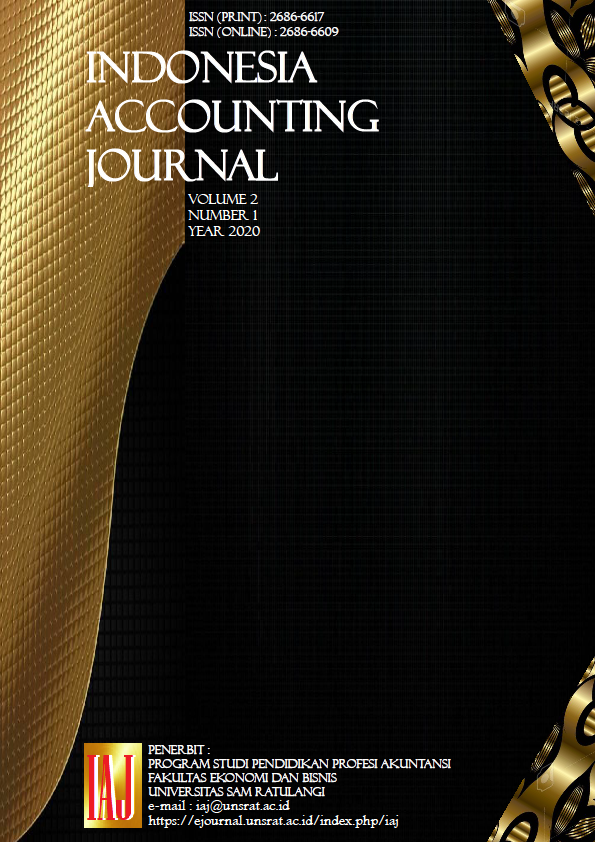Analisis pengaruh biaya kualitas dalam meningkatkan profitabilitas perusahaan PT. Putra Karangetang
DOI:
https://doi.org/10.32400/iaj.27713Keywords:
quality cost, profitability, Return on Investment (ROI)Abstract
Measuring quality qualitatively gave rise to the term quality cost. Quality costs at PT. Putra Karangetang turned out to have a considerable influence on the profitability of the Company, where by allocating greater costs to control and valuation would reduce the costs of internal failure and the cost of external failure so that the impact on profit was increasing. The purpose of this study was to analyze the effect of quality costs in increasing profitability at PT. Putra Karangetang. The method used is descriptive qualitative method and using Return On Investment (ROI) as a measure of company profitability. ROI value is influenced by the company's net profit compared to the company's total assets, and the results of research prove that quality costs incurred to produce quality products, and the contribution of quality costs greatly affect the increase in profitability of the company.References
Bustami, B., & Nurlela. (2013). Akuntansi biaya, Edisi 4. Jakarta: Mitra Wacana Media.
Firdaus, A. D., & Wasilah, A. (2014). Akuntansi biaya, Edisi 3. Jakarta: Salemba Empat.
Fahmi, I. (2014). Manajemen keuangan perusahaan dan pasar modal, Edisi I. Jakarta: Mitra Wacana Media.
Garrison, R. H., Noreen, E. W., & Brewer, C. P. (2012). Akuntansi manajerial, Edisi 2. Jakarta: McGraw-Hill.
Hansen, D. R., & Mowen, M. M. (2015). Management accounting, 8th Edition. New York: Cengage Learning.
Horngren, C. T., & Harrison, W. T. (2011). Akuntansi, Edisi 6. Jakarta: Indeks.
Jotlely, D. B., & Siaila, S. (2019). Analisis biaya kualitas (quality cost) terhadap pencapaian laba pada Rumah Sakit Sumber Hidup Kota Ambon. Jurnal SOSO-Q 7(1), 78-99. http://dx.doi.org/10.30598/sosoq.v7i1.989.
Kuncoro. (2011). Metode kuantitatif: Teori dan aplikasi untuk bisnis dan ekonomi. Yogyakarta: Sekolah Tinggi Ilmu Manajemen YKPN.
Krismiaji, & Aryani, Y. A. (2011). Akuntansi manajemen, Edisi 2. Yogyakarta: UPP STIM YKPN.
Mulyadi, (2014). Akuntansi biaya, Edisi 5. Yogyakarta: STIE YKPN.
Munawir, S. (2014). Analisa laporan keuangan, Edisi 4. Yogyakarta: Liberty.
Sartono, A. R. (2010). Manajemen keuangan teori dan aplikasi, Edisi 4. Yogjakarta: BPFE.
Siregar, B., Suripto, B., Hapsoro, D., Lo, E. W., Herowati, E., Kusumasari, L., Nurofik., & Suadi, A. (2014). Akuntansi biaya, Edisi 2, Jakarta: STIE-YKPN.
Sugiyono. (2012). Metode penelitian kuantitatif dan kualitatif dan R&D. Bandung : Alfabet.
Winarno. S. H. (2014). Analisis pengaruh biaya kualitas terhadap tingkat keuntungan perusahaan (Studi kasus pada CV. Meranti Manunggal Furniture). Moneter: Jurnal Akuntansi dan Keuangan, 2(2), 205-214. https://ejournal.bsi.ac.id/ejurnal/index.php/moneter/article/view/976.
Downloads
Additional Files
Published
Issue
Section
License
The articles published in Indonesia Accounting Journal are licensed under Creative Commons Attribution 4.0 International License with authors as copyright holders.
Â

This work is licensed under a Creative Commons Attribution 4.0 International License.
Â
Under this license then authors free to:
- Share — copy and redistribute the material in any medium or format.
- Adapt — remix, transform, and build upon the material for any purpose, even commercially.
Under the following terms :
- Attribution — You must give appropriate credit, provide a link to the license, and indicate if changes were made. You may do so in any reasonable manner, but not in any way that suggests the licensor endorses you or your use.
- No additional restrictions — You may not apply legal terms or technological measures that legally restrict others from doing anything the license permits.
Notices:
- You do not have to comply with the license for elements of the material in the public domain or where your use is permitted by an applicable exception or limitation.
- No warranties are given. The license may not give you all of the permissions necessary for your intended use. For example, other rights such as publicity, privacy, or moral rights may limit how you use the material.


